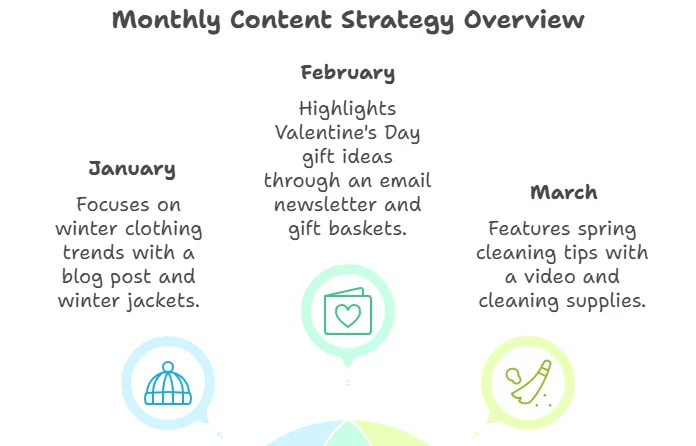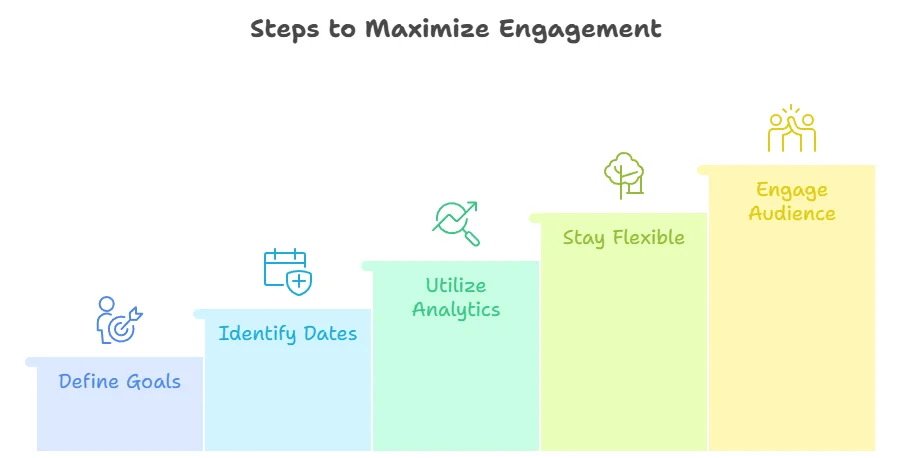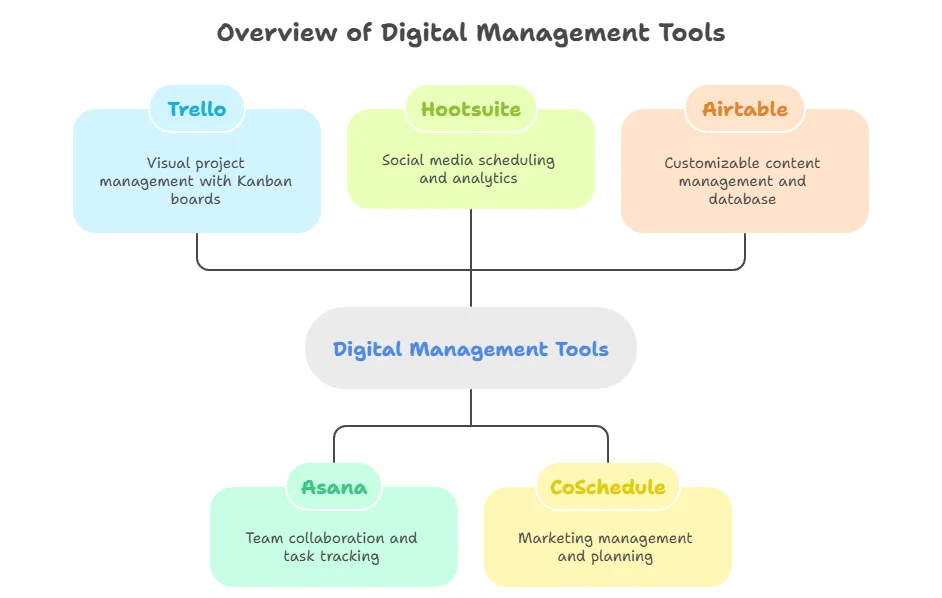 ATTENTION: Want to Learn Affiliate Marketing from Successful Affiliates?
Join this FREE community where successful marketers share their secrets!
Learn directly from highly successful affiliate marketers
Access free, actionable training content regularly
Connect with an active community of over 5,000 members
Network with multiple six-figure earning affiliates
Get your questions answered by real experts
JOIN FREE NOW!
ATTENTION: Want to Learn Affiliate Marketing from Successful Affiliates?
Join this FREE community where successful marketers share their secrets!
Learn directly from highly successful affiliate marketers
Access free, actionable training content regularly
Connect with an active community of over 5,000 members
Network with multiple six-figure earning affiliates
Get your questions answered by real experts
JOIN FREE NOW!
Essential Elements of an Affiliate Content Calendar
- Timely Topics: Select relevant themes based on holidays, seasonal trends, or current events. Understanding your audience’s interests at different times can improve your chances of successful engagement.
- Content Types: Include a variety of formats such as blog posts, social media updates, email newsletters, and videos. This diversity keeps your audience engaged and accommodates different preferences.
- Affiliate Links: Make sure to incorporate affiliate links strategically within your content. Analyze which products or services will resonate best with your audience and highlight them throughout your calendar.
Next, it’s essential to choose the right tools for organizing your calendar. Some popular options include Google Calendar, Trello, and Asana. These tools can help you track deadlines, brainstorm ideas, and collaborate with team members effectively. Choose a platform that suits your needs and is easy for you to navigate.
Once you have your tools in place, start filling out your calendar. Here are steps to create your content plans:
Steps to Create Your Content Plans
- Set Goals: Before you add content, establish clear objectives. Are you aiming to increase conversions, attract more visitors, or grow your email list? Clarifying these goals will inform the type of content you create.
- Research Keywords: Conduct thorough keyword research for SEO. Find keywords that are relevant to your niche and have a good monthly search volume. Integrating these keywords into your content enhances your visibility on search engines.
- Create a Monthly Overview: Lay out a month-by-month plan. Assign specific dates for content creation, publishing, and sharing on social media. This creates a clear roadmap of what you will be working on consistently.
A sample layout for your Affiliate Content Calendar can look like this:
| Month | Content Topic | Content Type | Publish Date | Affiliate Product |
|---|---|---|---|---|
| January | Winter Clothing Trends | Blog Post | January 10 | Winter Jackets |
| February | Valentine’s Day Gift Ideas | Email Newsletter | February 5 | Gift Baskets |
| March | Spring Cleaning Tips | Video | March 15 | Cleaning Supplies |

With your calendar established, it’s crucial to stay flexible. Trends change rapidly, and you need to adapt your content accordingly. Keep an eye on industry news and popular events to add timely content when needed. This adaptability can set you apart from competitors who may have rigid strategies.
Monitoring your results is just as important as planning. Use analytics tools to track the performance of your affiliate links and content. This data will allow you to pinpoint which content resonates with your audience and where adjustments might be needed. Tools like Google Analytics and ClickMeter can provide valuable insights into your campaigns.
Remember to promote your content consistently. Leverage social media channels, engage with your audience, and use email marketing to expand your reach. The more visibility your content gets, the higher the chances of generating successful affiliate income.
Implementing a well-structured Affiliate Content Calendar takes time and effort, but the returns can be significant. By staying organized, you can engage your audience effectively and maximize your affiliate marketing success.
How to Choose the Right Tools for Managing Your Content Calendar
When managing your content calendar, choosing the right tools can make a significant difference. The right tools can enhance your planning, collaboration, and execution processes. Here’s a guide to help you explore the best options available to you.
Assess Your Needs
Before diving into the vast ocean of content management tools, it’s key to assess your needs. Consider what you require in terms of:
- Features: Do you need content scheduling, analytics, or team collaboration features?
- Team Size: Are you working solo or do you have a large team managing content?
- Budget: What is your budget for these tools? Some offer free versions while others require subscriptions.
Taking the time to analyze these aspects will help narrow down your options. For instance, if you’re a solo blogger, a simpler tool may suffice, whereas larger teams might require comprehensive software.
Explore Popular Tools
Several tools are well-regarded in the content management realm. Both paid and free options can cater to your needs. Here are some popular choices:
| Tool | Best For | Price |
|---|---|---|
| Trello | Visual project management | Free / $10 per month |
| Asana | Team collaboration | Free / $10.99 per user per month |
| Hootsuite | Social media scheduling | Starting at $19 per month |
| CoSchedule | Marketing management | Starting at $19 per month |
| Airtable | Customizable content management | Free / $12 per user per month |
Look for Integration Capabilities
Another vital consideration is integration capabilities. You want your content calendar tool to work seamlessly with other tools you already use, such as email marketing platforms, analytics services, or social media management tools. Integration enhances efficiency and streamlines your workflow. Popular tools like Zapier can help you connect apps and automate repetitive tasks.
User Experience and Support
The user interface of your chosen tool should be intuitive and easy to navigate. A complicated tool might lead to frustration among team members, reducing overall productivity. Before making your choice, take advantage of free trials to see how user-friendly the tool is. Additionally, check the level of support provided. Are there tutorials, customer service, and community forums available?
Mobile Accessibility
In today’s fast-paced world, having a mobile-friendly tool is a bonus. A content calendar that can be accessed via a mobile app ensures you and your team can stay organized and up to date, even when away from your workstations. You can quickly add ideas, check schedules, and make adjustments on the go.
Gather Feedback and Iterate
Once you’ve implemented a tool, gather feedback from your team on its effectiveness. Is it meeting their needs? Is there anything they find particularly helpful or challenging? Regular feedback allows for continuous improvement in your content management process.
Choosing the right tools to manage your content calendar can significantly impact your efficiency and success. By assessing your needs, exploring popular options, checking for integrations, and ensuring user-friendliness, you can find a solution tailored to your unique requirements.
By leveraging these strategies and tools, you can streamline your content creation process and maintain a steady flow of engaging material. Don’t hesitate to invest the time in finding the right applications, as they can save you time and increase your content’s effectiveness in the long run. For more insights and updates on managing your content effectively, visit HubSpot and Neil Patel’s blog.
Strategies for Aligning Affiliate Promotions with Seasonal Trends
Aligning your affiliate promotions with seasonal trends can significantly enhance your marketing effectiveness and boost your revenue. By tapping into seasonal interests, you not only cater to consumer behavior but also position your offerings at the forefront of their minds. Here are some strategic approaches to help you achieve this alignment.
Understand Seasonal Trends
To start, it’s crucial to grasp which seasons or events are relevant to your audience. Common seasonal trends include:
- Holidays (Christmas, Thanksgiving, Valentine’s Day)
- Back-to-school season
- Summer vacations
- Black Friday and Cyber Monday
Each of these periods comes with unique shopper priorities. By understanding these, you can tailor your content and promotions accordingly.
Use an Affiliate Content Calendar
Implementing an Affiliate Content Calendar is an essential step to organize your promotional strategies. A content calendar helps you plan and schedule when to push specific items or campaigns. Here are some tips for creating one:
- Mark key dates: Identify important holidays and events that your audience celebrates.
- Plan ahead: Schedule promotional content at least a month in advance for major seasons.
- Track performance: Use analytics tools to see which promotions perform best during each season.
Create Relevant and Useful Content
Your best approach is to create engaging content that is closely related to the season. You can do this by:
- Writing blog posts about seasonal trends.
- Creating product reviews and comparisons that are pertinent to the season.
- Using social media to share engaging visuals of seasonal products.
The goal is to create content that not only promotes your affiliate products but also adds value to your audience’s experience.
Leverage Email Marketing
Email marketing remains a powerful tool to connect with your audience. Here are some strategies to consider:
- Send seasonal newsletters with curated product lists.
- Include time-limited offers to entice immediate purchases.
- Create urgency with countdowns to major holidays or events.
By crafting well-timed, relevant emails, you can nurture relationships and drive higher conversions.
Utilize Seasonal Keywords for SEO
To boost your search engine visibility, incorporate seasonal keywords into your content. This means analyzing popular search terms related to the season. Use tools like Google Trends to identify what people are searching for and include those keywords in:
- Blog posts
- Product descriptions
- Email subject lines
By aligning your content with what users are actively looking for, you increase your chances of attracting their attention and driving traffic to your site.
Engage with Social Media Trends
Social media platforms are great for catching seasonal waves. Consider these tactics:
- Run contests or challenges related to the season.
- Utilize seasonal hashtags to increase visibility.
- Collaborate with influencers to spread the word about your affiliate products during peak seasons.
Engaging with your audience where they spend their time can help you effectively promote seasonal products.
Analyze and Adjust
After each season, take the time to analyze your strategies to understand what worked and what didn’t. Use tools like Google Analytics to track performance metrics such as:
- Traffic sources
- Conversion rates
- Customer engagement
By understanding your successes and areas for improvement, you can refine your approach for the next seasonal trend. This may include adjusting your content calendar, exploring new promotional tactics, or focusing on more successful products.
Aligning your affiliate promotions with seasonal trends can take your marketing efforts to a new level. By understanding trends, creating engaging content, leveraging social platforms, and utilizing performance analysis, you can maximize your affiliate potential. Keep your audience in focus, and continue adapting strategies to meet their seasonal needs.
Maximizing Engagement Through Consistent Content Scheduling

In the fast-paced digital marketing landscape, ensuring consistent content delivery is key to maximizing audience engagement. When you maintain a regular schedule for your content, you not only build anticipation among your readers but also enhance your credibility. A well-planned content calendar, particularly one focusing on affiliate marketing, can significantly improve your outreach and conversion rates. This approach leads to a more engaged audience, ready to interact with your content physically and emotionally.
One major benefit of using an Affiliate Content Calendar is that it allows you to align your content strategy with marketing campaigns and seasonal trends. This method helps you to capitalize on peak times when audience interest is at its highest. Here are some strategic steps to create an effective calendar:
Define Your Goals
Before creating your calendar, it’s essential to have clear objectives in mind. Ask yourself what you want to achieve. Are you aiming for brand awareness, lead generation, or increased sales? Your goals will influence the types of content you produce. For affiliate marketers, you might consider:
- Increasing blog traffic
- Boosting affiliate sales
- Enhancing audience engagement
Identify Key Dates
Integrate key dates into your calendar. These could range from holidays to industry-specific events. Identifying special days allows you to create timely, relevant content. For instance, if you are promoting fitness products, you may want to focus on New Year’s resolutions or summer fitness trends. Here’s an example of how to layout important dates:
| Date | Event | Content Idea |
|---|---|---|
| January 1 | New Year’s Day | Kickstart Your Fitness Journey: Top 5 Products for 2023 |
| July 4 | Independence Day | Summer Sales: Must-Have Outdoor Gear |
Develop a Content Mix
A diverse content mix keeps your audience engaged. Instead of focusing solely on promotional content, incorporate informational and entertaining pieces. Here are some content types to consider:
- Blog posts that provide value
- How-to guides that solve problems
- Product reviews with affiliate links
- Videos demonstrating product effectiveness
This mix ensures you cater to your audience’s various interests while subtly promoting affiliate products. Regularly mixing content types can help to maintain viewer interest and promote interaction.
Utilize Analytics
Regularly monitor the performance of your content. Use tools like Google Analytics to track which posts drive the most traffic and conversions. This data is invaluable in refining your calendar and ensuring you focus on content types that resonate with your audience. For deeper insights, check resources such as HubSpot’s marketing blog or Neil Patel’s blog.
Stay Flexible
Even with a well-laid plan, be ready to adapt. Trends and audience preferences can change quickly. Staying flexible allows you to seize on opportunities that may arise, such as trends in affiliate marketing or emerging platforms. Don’t hesitate to adjust your Affiliate Content Calendar to incorporate timely topics that your audience cares about.
Engage with Your Audience
Encourage engagement by creating interactive content. You might include polls, quizzes, or even live Q&A sessions related to your content. These tactics can boost audience participation and deepen their connection with your brand. Always stay responsive to comments and feedback; this builds a community around your content and enhances loyalty.
An Affiliate Content Calendar is essential for maintaining a consistent schedule that maximizes engagement. With a strategic approach that aligns your content with audience preferences and key dates while remaining flexible, you will not only boost your engagement rates but also enhance the effectiveness of your affiliate marketing efforts.
For further insights on maximizing your content strategy, explore Content Marketing Institute or Search Engine Journal. Continuously refining your strategy can lead to measurable growth in your affiliate marketing success.
Analyzing Performance: Adjusting Your Calendar for Better Results
Managing an Affiliate Content Calendar can significantly impact your marketing success. However, analyzing the performance of your campaigns and adjusting your calendar accordingly is crucial for maximizing engagement and revenue. The key is to establish a systematic approach that allows you to constantly refine your strategies. Here’s how you can boost your results by analyzing performance and modifying your content calendar effectively.
First, it’s important to track the right metrics. By focusing on specific key performance indicators (KPIs), you can gain insight into what works and what doesn’t. Here are some valuable metrics to monitor:
- Traffic Growth: Analyze the number of visitors to your affiliate links and content pages.
- Conversion Rate: Measure the percentage of visitors who take the desired action, such as clicking through to a product page or completing a purchase.
- Engagement Rates: Look at comments, shares, and likes to understand how your audience is interacting with your content.
- Bounce Rate: Track the percentage of visitors who leave your site without engaging with any content.
Once you gather this data, you can start analyzing it to identify patterns. For instance, if you notice a spike in traffic during a specific time of the year, it could indicate that your audience is more receptive to certain types of content during that period. Similarly, if content consistently underperforms, it may be time to consider revising or replacing it.
Adjusting your Affiliate Content Calendar requires flexibility and responsiveness. Consider these strategies for making impactful changes:
- Seasonal Adjustments: Plan your content around seasonal trends. If you notice certain products sell better during holidays or back-to-school periods, it’s beneficial to create content that aligns with these times.
- Experiment with Formats: If a particular format, like video or infographics, engages users better than articles, add various formats to your calendar to cater to diverse audiences.
- Feedback Integration: Encourage audience feedback to adjust your content offerings. Surveys can help direct where adjustments may be beneficial.
- Repurpose Content: If a piece of content underperformed, think about how it can be repurposed. Updating old posts with fresh information can improve engagement.
Another critical area to examine is the timing of your posts. Analyze when your audience is most active online. Tools such as Buffer can help you determine optimal posting times based on engagement metrics. Scheduling your content to post during peak hours can dramatically influence its visibility and performance.
Regularly revisiting and adjusting your strategy is also important. Set regular checkpoints to review your calendar and make necessary changes. Monthly reviews allow you to stay on top of trends and quickly pivot when you see something isn’t working.
Consider using a simple table format to document your findings and planned adjustments:
| Month | Content Type | Performance Metrics | Adjustments Needed |
|---|---|---|---|
| January | Blog Post | Low Traffic, High Bounce Rate | Update with current trends, SEO optimization |
| February | Infographic | High Engagement, Good Traffic | Promote on social media more |
| March | Video Content | Average Performance | Modify content based on feedback |

Always stay informed about industry trends. Subscribe to related websites, newsletters, and forums that focus on affiliate marketing strategies. Resources like Affiliate Buzz and BloggersIdeas provide fresh insights that can guide your adjustments effectively.
Your Affiliate Content Calendar is not static. Analyzing performance and optimizing accordingly can lead to better results over time. Embrace the process and remain open to adjusting your strategies. You’ll find that the more you involve data in your decision-making, the more successful your affiliate marketing efforts will become.
Conclusion
Creating and implementing an effective Affiliate Content Calendar is essential for driving success in your affiliate marketing efforts. By carefully planning your content, you can strategically align your promotions with seasonal trends, ensuring that your audience receives relevant and timely information. Choosing the right tools for managing your calendar not only simplifies the scheduling process but also enhances collaboration and productivity.
Engagement thrives on consistency, and by regularly posting valuable content, you create a reliable source of information for your audience, helping to build trust and brand loyalty. Furthermore, by analyzing the performance of your content, you can make data-driven adjustments to your calendar, optimizing your strategy for better results.
Remember, your audience is at the heart of your affiliate marketing efforts. Focus on delivering content that meets their needs and interests, and make adjustments based on feedback and engagement metrics. Ultimately, an organized and well-thought-out Affiliate Content Calendar will support your goals, streamline your workflow, and enhance your ability to connect with your audience. Embrace the power of planning, adapt to changing trends, and watch your affiliate marketing ventures flourish.
